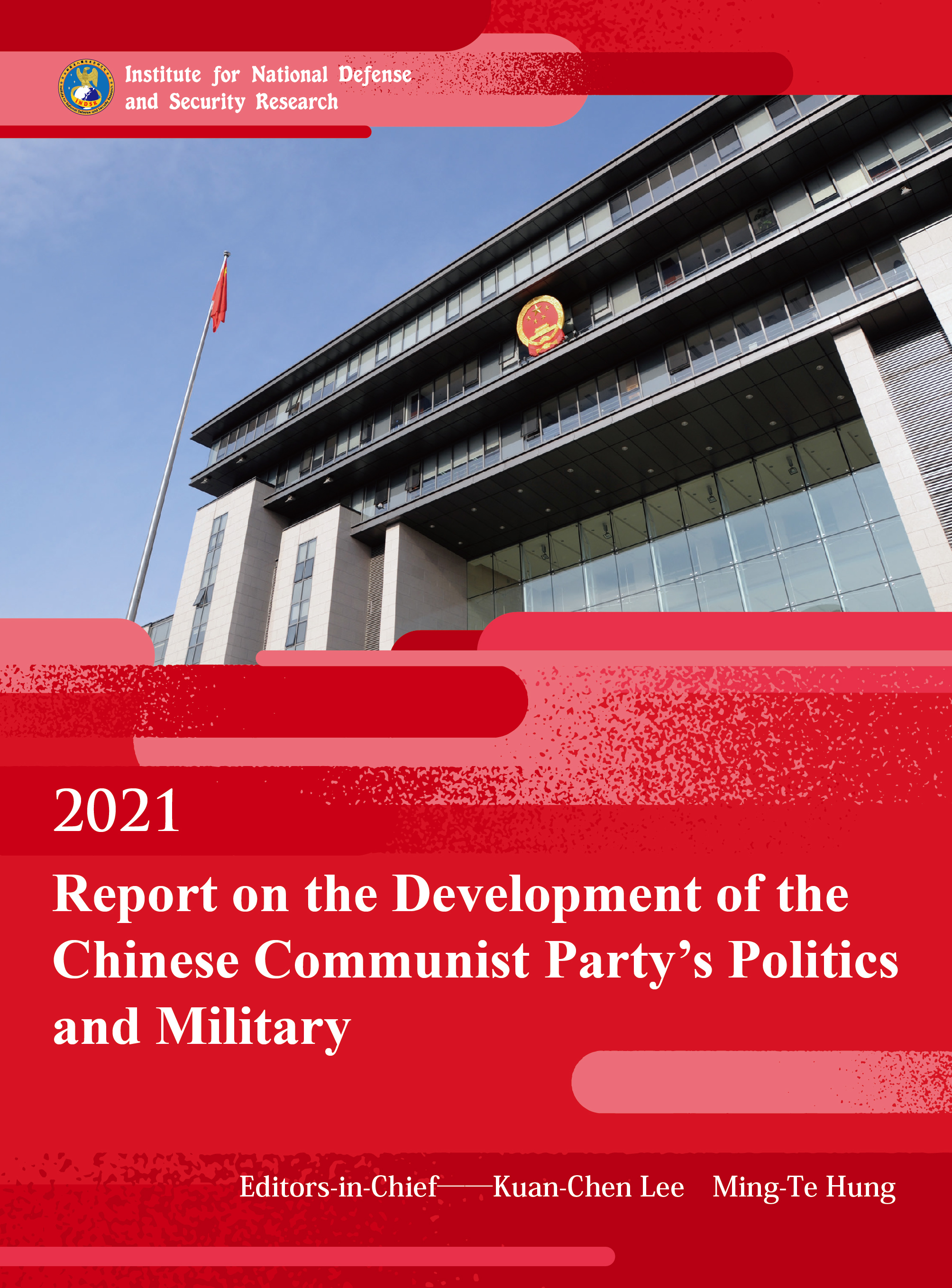結論
2022.06.07
Views
263
PDF link:
2021 Report on the Development of the Chinese Communist Party’s Politics and Military-Conclusion.pdf
Conclusion
The year 2021 is an important year for China to achieve its first 100-year goal of alleviating poverty and building a moderately prosperous society on the 100th anniversary of the CCP, which is emblematic of the Chinese regime and Xi Jinping’s personal leadership. In 2020, problems such as the COVID-19 pandemic, U.S.-China relations and the domestic economy have posed a challenge to the CCP’s governance. In 2021, China is not only exposed to these relentless headwinds, but must also confront new crises and challenges. For example, unlike the former Trump administration, the U.S. President Joe Biden has taken a different approach to China, but his administration persists in its containment of China as the competitive situation and value differences between the two countries remain unchanged. As a result, to facilitate further understanding of China’s policies, challenges and responses on the 100th anniversary of the CCP, this report looks into the political, military and socio-economic aspects of China, with the conclusions of each chapter set out below:
Firstly, the politics part consists of four articles. The first chapter aims to examine the 14th Five-Year Plan and 2035 Visionary Goals, and the changes in China’s economic strategy, identifying the following two policies that may have a bearing on the development of state capitalism in China. China’s “new nation wide system” will lead the development of strategic technologies. China attaches importance to the role of enterprises in innovation and R&D, and to those that possess strategic technologies or hold R&D potential. China’s management of state-owned enterprises (SOEs) will shift from “enterprise management” to “capital management” by: (1) reinforcing the state’s role to SOEs as capital contributors, and downplaying the hierarchical relationship between the upper and lower levels; (2) stressing the efficiency of state-owned capital investments, and emphasizing the importance of investment returns and the growth of state-owned capital. Therefore, the Chinese government’s involvement in economic affairs in the future will focus on exercising the legitimate rights of a shareholder as a channel for the state to intervene in corporate governance or influence industrial development, for example, by becoming an “investor state,” where the CCP holds a stake in a private company with investment potential through the power of state-owned capital or even by treating companies run on state-owned capital as the core, and creating corporate groups with cross-shareholdings in each other, in a bid to grow state owned capital and strengthen Chinese-funded enterprises.
The second chapter is devoted to an exposition of the realignments and shifts in China’s Taiwan policy in 2021, with the Tsai Ing-wen administration taking office and China’s unilateral approach to Taiwan and its unilateral threats. Nevertheless, when other policy approaches such as wolf warrior diplomacy are taken into consideration, it can be seen that China is reinforcing its internal propaganda by taking a hard line externally. With regard to the Taiwan policy, the Taiwan Affairs Office and the Ministry of Foreign Affairs of the PRC have frequently taken a tough stance in their Taiwan-related remarks, in addition to the various policies they have steadily introduced on a unilateral basis. Overall, under the “Xi’s Five-Point Plan,” a policy of integrated development, information warfare, disinformation and cognitive warfare, as well as military threat against Taiwan, have been carried out without interruption.
Chapter 3 deals with the division of tasks regarding Taiwan-related issues between the Ministry of Foreign of the PRC and the Taiwan Affairs Office, as well as the strategies adopted by the two agencies, with the former responsible for external affairs, while the latter for Taiwan affairs. In terms of strategy, the foreign affairs ministry adopts a hard-line stance on external affairs with “wolf warrior diplomacy” and occasionally intervenes in Taiwan-related issues against the Taiwanese government, while the Taiwan affairs office takes a “hard and soft-handedˮ approach towards the Taiwanese government and the private sector respectively. However, this has not worked well as the use of “wolf warrior diplomacy” not only is greeted with disapproval in the international community and tarnishes China’s global image, but also is detrimental to the development of the cross-strait relations and offsets the soft tactics employed by the Taiwan affairs agency. Finally, the Taiwanese government and the private sector should respond to the respective statements made by the two Chinese agencies, with the former advised to resort to democratic values, technological mutual assistance and pandemic prevention experience and the latter to adopt a scientific approach to evaluating the efficacy of Chinese vaccines or procured international vaccine brands, allowing the public to make an objective judgement without being influenced by political propaganda or false information.
Chapter 4 focuses on the risks and controversies arising from China’s “One Belt, One Road” initiative, indicating that the main purpose of the initiative is to tackle its own domestic overcapacity problem and to enhance the internationalization of Chinese enterprises. In this regard, the international community is aware of the huge debt problem that the Belt and Road Initiative poses to the countries along the route. Debt diplomacy has become a convenient and powerful diplomatic tool for China, helping to expand its political and economic influence. Consequently, in response to the implications and challenges brought about by the Belt and Road Initiative, major countries such as the U.S. and Japan have rolled out their own infrastructure projects, which may lead to more intense competition for infrastructure among countries in the future. In addition, the exchange and trade between regions will not only lead to the spread of invasive species, but also increase the risk of importing diseases, and there may be occasions for Taiwanese businessmen to engage in related construction projects in the future, and some of the countries along the “Belt and Road” route overlap with the target countries of the “New Southbound Policy,” which may expose our country to ecological and health risks.
Secondly, the military part contains three articles, with Chapter 5 examining the evolution of Chinese military aircraft flying over the sea, pointing out that the pattern of flight training has shifted from crossing over the median line of the Taiwan Strait and encircling Taiwan to disrupting Taiwan’s southwestern airspace. Chinese military aircraft have frequently made their way into the southwest airspace to highlight Taiwan’s defensive weaknesses arising from its emphasis on deployment to the north, to deplete Taiwan’s air power and logistical supply capabilities, to demonstrate the PLA’s ability to launch multi-directional and multi-domain attacks against Taiwan, and to threaten the outlying islands of Pratas and Spratly. In response, Taiwan should deploy a new type of early-warning radar, build up its southwest airspace surveillance capabilities, enhance its air defense capabilities, strive for the procurement of electronic warfare (EW) aircraft, and foster cooperation and exchanges with its allies on anti-submarine warfare, electronic warfare and surveillance.
Chapter 6 concerns the military preparedness of the People’s Liberation Army (PLA) in the South China Sea. After Xi Jinping came to power, strengthening “warfare infrastructure” has become the cornerstone of military preparedness in the South China Sea. On the one hand, the PLA has been dredging up coral reefs and creating artificial islands in the South China Sea, while on the other, it has been demonstrating its military presence in the South China Sea through military patrols. In terms of the combat activities involved in offshore exercises or distant sea training, China has placed a premium on stepping up the two major operational systems of landing on islands and reefs and joint multi-services operations, accelerating the integration of the new main warships with the existing forces in an effort to meet the need for greater deterrence and intimidation of foreign forces. Meanwhile, the confrontation between the U.S. and Chinese naval forces in the South China Sea has intensified, but the PLA has avoided escalating the standoff or even clashing with U.S. forces. As for underwater patrols and demonstrations of military power, China holds back foreign forces in the South China Sea to a limited extent, but benefits from a degree of “home turf advantage” due to its greater control over the limited underwater shipping lanes in the region. Therefore, “telling the story of the PLA’s deterrence in the South China Sea” has become the main instrument for the PLA to showcase its military strength in the South China Sea.
Chapter 7 examines how the PLA takes to social media for military propaganda. By looking at the four official Weibo accounts of the PLA, it identifies the dissemination and the trend of public opinion created by the PLA. The study found that the PLA’s propaganda is highly strategic, capitalizing on seemingly random postings to draw audiences into the its channels and facilitate the implantation of the military’s ideas and positions. At the same time, the PLA’s propaganda campaigns aim to be more effective by posting messages at the right time, and the proportion of different types of articles is tailored to the area of responsibility of different theater commands. On the whole, the PLA’s propaganda is strategic, timely and targeted, moving towards an information-based approach and an enhanced strategic deterrent effect. In the future, the possible weaponization of propaganda in conjunction with artificial intelligence (AI) warrants our utmost attention and vigilance.
Finally, the economic and social part comprises three articles. Chapter 8 probes into the economic situation in China and its semiconductor industrial policy in 2021, suggesting that China’s economic performance in the first half of 2021 was strong, but weak in the second half, in the wake of the U.S.-China tensions and the COVID-19 pandemic. China’s dual circulation policy and the 14th Five Year Plan, which seek to drive economic growth through domestic demand and achieve technological autonomy on the back of semiconductor support programs, are proving difficult as China’s economic growth is still dependent on government led investment. Prior to the U.S.’ technology embargo, China’s semiconductor development was booming, but it still relied heavily on foreign imports for high end chips. At this stage, despite the Chinese government’s continued backing for the local wafer industry in the form of equity investment, tax and fee reductions and preferential loans, the future growth of chip manufacturing will be significant, but it remains to be seen whether it will be able to catch up with its foreign competitors.
Chapter 9 delves into China’s aerospace science and technology and industrial development, firstly finding that its aerospace science and technology development is primarily aimed at military applications. While still lagging behind the U.S. in some areas of expertise, its development of space military capabilities has posed a certain military threat to the U.S. Second, China develops aerospace science and technology principally with the aid of the aerospace and defense industry and the Chinese Academy of Sciences, spearheading the development of critical power and inertia technologies, satellite launching, mapping, software development, and satellite networking. Third, by incorporating its strengths in emerging technologies such as AI, China has developed considerable space capabilities, such as the BeiDou satellite navigation system, space station docking and Mars landing. Forth, China utilizes BeiDou navigation and satellite applications to expand its geopolitical sphere of influence. For example, Laos has fully embraced the Chinese model of “whole-satellite export,” which is tantamount to being integrated into its aerospace sphere of influence. Whether this model will be replicated in other regions remains to be seen.
Chapter 10 deals with China’s intensified regulatory measures at all levels of society, the reasons for their tightening, and the future development of the country, pointing out that to preclude Western countries such as the U.S. from undermining the foundations of the CCP’s governance by influencing the development of China’s technology industry and national security, and to help maintain domestic political and economic stability to sustain Xi Jinping’s rule, China is addressing social issues that have caused public discontent and may threaten the authority of the Party’s leadership and Xi’s re-election. In other words, China needs a more solid Party spirit and a more united and stable society in response to increasingly grave challenges. Thus, Xi Jinping’s stricter control over the Internet and the media, the military and social organizations, and even ethnic groups, will not only help to consolidate his own authority but, more importantly, strengthen the Party’s leadership position for its long-term effective rule of China. It is expected that China will continue to step up its regulatory efforts in various sectors by means of a tougher and more centralized government system to cope with the huge demands of industrial upgrading and to avert the severe challenges posed by worsening social problems.



